Turtles Hatch!
Air Date: Week of December 29, 2017
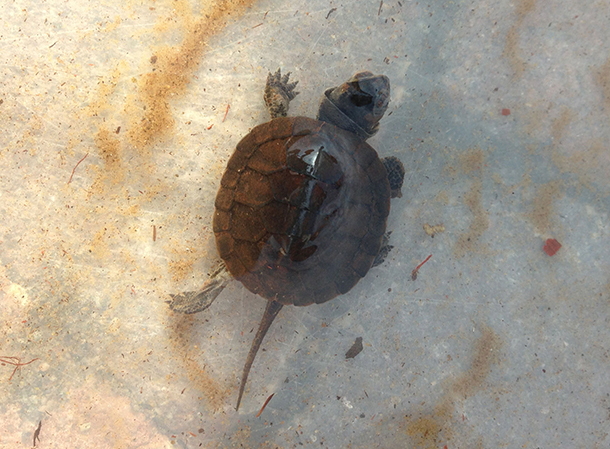
A baby Blanding’s turtle takes its first swim (Photo: Don Lyman)
Blanding’s turtles are considered a threatened species in Massachusetts, so Grassroots Wildlife Conservation is working to protect newly hatched turtles, as mortality is high in the first year. Living on Earth’s Don Lyman returns to the nest we observed in early summer with the biologists to find out how many eggs hatched, and help prepare the young turtles for their next adventure in local classrooms.
Transcript
CURWOOD: It’s a special Living on Earth today, and I’m Steve Curwood, revisiting the threatened Blanding’s turtles that go to school. In midsummer, our reporters went out with a team of biologists monitoring the Blanding’s’ turtles as they laid their eggs. A few months later, as the days grew shorter, Bryan Windmiller returned to Great Meadows in Concord Massachusetts to check on the nests with a couple of young assistants.
MARCO: I’m Marco. I am twelve.
ANA GRACIA: I’m Ana Gracia. And I’m ten.
WINDMILLER: It’s now – today’s, this is September 11th, right? So this is starting to get well into the period where the turtles are often hatching.
CURWOOD: Bryan is the executive director of Grassroots Wildlife Conservation, and he’s concerned about what effect the drought might have had on the nest of Turtle number 2028. That’s the mother we encountered when she laid her eggs back in June and this time, Living on Earth’s Don Lyman went along with Bryan as well.

A sponge helped keep Turtle 2028’s nest damp during the dry summer (Photo: Don Lyman)
WINDMILLER: Right now, just to make sure that things are okay we’re gonna just scratch down and take a look just at the topmost couple of eggs, and just see if those eggs look okay.
LYMAN: Bryan opens the wire mesh cage that surrounds the nest to protect it from predators like skunks and raccoons. There’s a large, yellow sponge on top of the soil -- to keep the soil moist, says Bryan.
WINDMILLER: We water the sponge, and we usually overwater it so we’re actually watering the nest a little bit, too -- the soil’s been so dry so just to make sure that the eggs aren’t dehydrating. The only thing is we didn’t start doing that until into August, and it was incredibly dry before then, too. So our concern is that maybe some of the embryos might have perished back in July, when it was really hot and dry as well. So, Ana Gracia and Marco, you guys can take some turns.
LYMAN: Marco and Anna Gracia carefully dig into the nest with their hands. And pretty soon…
ANA GRACIA: It’s a turtle!
MARCO: It’s alive.
ANA GRACIA: Ooh, let me see him!
WINDMILLER: That, I was going to say, is the other thing that we sometimes find is you dig down and you find that the turtles have hatched already.
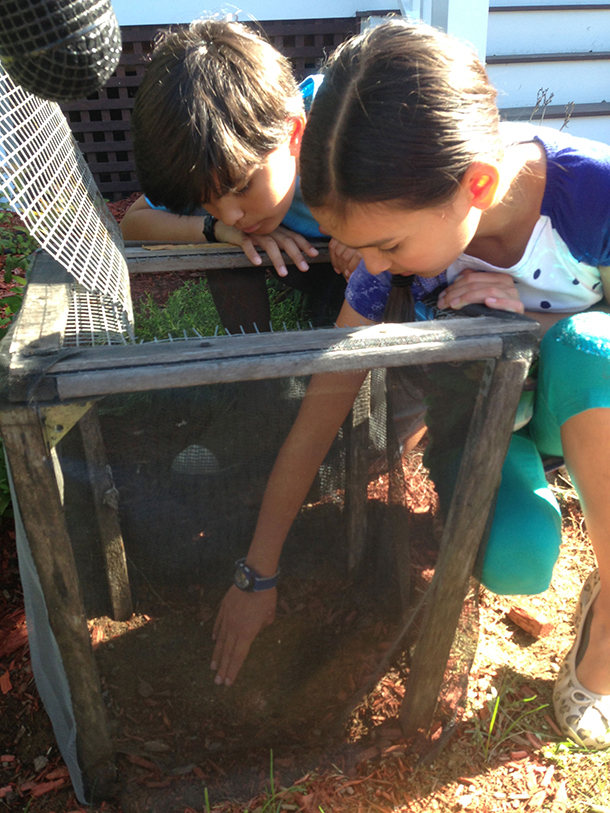
Marco, 12, looks on while his ten-year-old sister Ana Gracia carefully digs in the dirt of Turtle 2028’s nest. (Photo: Don Lyman)
ANA GRACIA: He’s okay, he’s so cute!
WINDMILLER: Looks wonderful. I’ll go turn the hose on.
ANA GRACIA: He’s teeny!
MARCO: He does weigh as much as a quarter.
ANA GRACIA: He weighs less than a quarter.
[WATER SOUNDS]
WINDMILLER: Yeah, you can soak it for a second and we’ll also soak the nest.
LYMAN: Ana Gracia rinses the little Blanding’s turtle off with a garden hose and puts it in a plastic tub with some water.
ANA GRACIA: He’s swimming. I was kinda surprised that they could swim, like, the second they got out.
WINDMILLER: …moisten the sponge. That one looks really good!
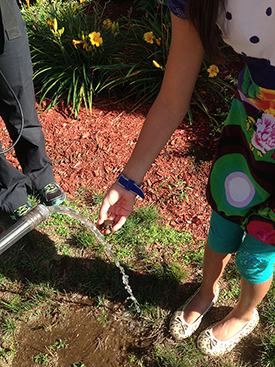
Ana Gracia rinses off the little turtle hatchling she found in the nest (Photo: Don Lyman)
LYMAN: Bryan thinks it’s best to leave the nest alone at this point, so the rest of the hatchlings can dig their own way out. When they do, these hatchlings will go to school – literally. Bryan entrusts them to school kids like Marco and Ana Gracia, who care for them in their classrooms and give them a head start in life.
A couple of weeks later, we’re back at the nest with Bryan Windmiller and program coordinator Emilie Schuler. Bryan says no baby turtles have emerged since Marco and Ana Gracia found that first one nearly two weeks ago.
WINDMILLER: Typically, we don’t see more than a week or so that goes by between when one hatchling emerges and when everybody else does. And we’ve found that rain often seems to motivate the hatchlings to come out of the ground, and we actually had one fairly decent rain just about three days ago, four days ago.
LYMAN: And time is running out, Bryan says, for the cold-blooded turtle hatchlings.
WINDMILLER: At this point, because the weather’s cooling down, it becomes harder and harder for the hatchlings that are underground to have the energy to dig themselves out.
LYMAN: Bryan and Emilie take off the mesh cage that’s been protecting the nest.
WINDMILLER: Okay, you gonna go for it, Emilie?
SCHULER: Okay.
[DIGGING SOUNDS]
SCHULER: Oh, what’s this – Oh, that’s the—
WINDMILLER: --Temperature logger.
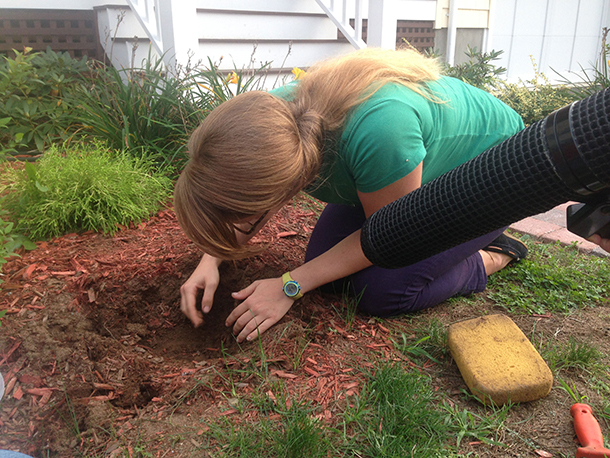
Grassroots Wildlife Conservation Program Director Emilie Schuler gently digs into the nest in search of any remaining hatchlings. (Photo: Don Lyman)
SCHULER: Temperature logger. Okay, well, we’ve got that.
WINDMILLER: So this records the temperature every hour. It will allow us to predict with reasonable accuracy whether the hatchlings are boys or girls.
[DIGGING SOUNDS]
SCHULER: So I think I’m seeing our first little friend here. There’s a something, some egg and some movement.
WINDMILLER: Oh! That’s looking good.
SCHULER: There’s movement. There he is.
WINDMILLER: It’s a little one.
SCHULER: Awww.
WINDMILLER: Yeah, wonderful! Looks like that one, too, has been hatched for a little bit, just been sitting there.
LYMAN: Emilie digs down further into the nest.
WINDMILLER: So Emilie just dug up – here’s an egg, that -- you can feel, it’s got a-- a formed embryo inside of it. But I’m suspecting that, uh—
LYMAN: It might not be alive?
WINDMILLER: Yeah, that it’s not viable anymore. This also, this nest may be pretty small because this was a first-time mom, and first-time moms often lay pretty few eggs compared to the normal average of about ten.
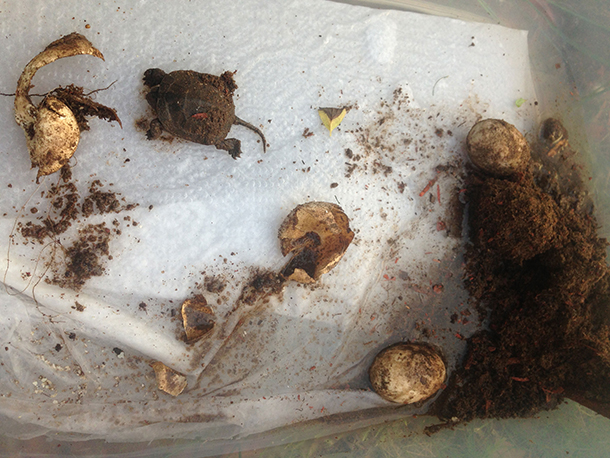
Turtle 2028’s first clutch of eggs yielded two live hatchlings, an eggshell without an embryo, an egg containing an embryo that never developed into a turtle, and a tiny hummingbird-sized infertile egg. (Photo: Don Lyman)
LYMAN: Oh, looks like some more eggs there.
WINDMILLER: Mm-hmm.
SCHULER: Yep, but, again –
WINDMILLER: So this one doesn’t have an embryo in it.
LYMAN: How can you tell?
WINDMILLER: You feel it’s really light, it’s all dried up.
LYMAN: Oh yeah.
WINDMILLER: And that may be pretty much the nest, right?
SCHULER: There’s something else down here.
WINDMILLER: Ah, is there? Oh, yep--
SCHULER: Oh!
WINDMILLER: Oh, I’ve seen that before.
SCHULER: Look at that! A tiny egg!
LYMAN: So tiny. Why is it so tiny?
WINDMILLER: So that’s also something that we saw once before with a first-time mother, right across the street from here, who -- you know, you could tell she was sitting there working, laying, and then very carefully burying things. And we always, when we put the screen over the nest we dig down just to make sure that she actually laid eggs, and we were quite sure that she’d done something, but I dug down, and I didn’t see anything, and I kept digging down, and I just had one little tiny egg – you know, this is the size of a parakeet egg.
LYMAN: Or maybe a hummingbird egg.
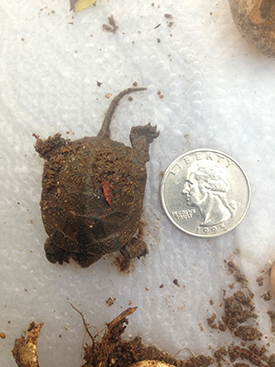
The tiny turtle hatchling Emilie excavated was only a bit bigger than a quarter. (Photo: Don Lyman)
[LAUGHING]
WINDMILLER: Or maybe a hummingbird egg, this is not the size of a Blanding’s turtle egg! I think it’s just something physiological about first-time moms.
LYMAN: Bryan says he’ll dissect the egg that has an embryo inside, but not yet, because—
WINDMILLER: My wife, who is a wildlife veterinarian, always reminds me – when you work with reptiles, their metabolisms are so slow, it’s not always easy to tell when they’re dead or not!
LYMAN: Oh!
[LAUGHING]
WINDMILLER: So, so I will take that egg, actually. And I’m gonna take a little bit of the soil over here, and just in case, you know, I’m wrong, I’m just gonna put it in a container for a little bit, just to see if anybody does hatch from it before I break the shell open.
LYMAN: All in all, Turtle 2028 laid four eggs in her nest.
WINDMILLER: That’s less than half the size of a typical Blanding’s turtle clutch. And two out of the four survived, which is also low.
LYMAN: Normally about eighty percent of the eggs produce hatchlings. The low survival rate of the eggs of these threatened turtles seems to be a trend this year in New England.
WINDMILLER: We did hear from U.S. Fish and Wildlife Service, they’re monitoring the only relatively large population of Blanding’s turtles left in Massachusetts, and I believe they had 59 nests that they monitored this year. And their average hatching success was just over 5 hatchlings per nest, and that’s very low. And I would put up drought as my first guess as to why that’s been the case.

Bryan Windmiller founded Grassroots Wildlife Conservation (now part of Zoo New England) and is now Director of Zoo New England's Conservation department. (Photo: Grassroots Wildlife Conservation)
LYMAN: Since as many as 80% of Blanding’s turtles don’t make it through their first winter, Grassroots Wildlife Conservation steps in. The turtles grow much faster when cared for by humans than in the wild, Bryan Windmiller says.
WINDMILLER: By the time we let them go they’re usually the size of, say, a wild four-year old. The first year their survival rate is really high, it’s around 85, 87%. And by the second year after we let them go it’s around 96%.
LYMAN: The tiny Blanding’s turtle that Emilie unearthed from the nest of turtle 2028 may have come from a small clutch, but the nine months of boarding school that awaits it gives this little guy – or gal -- a good shot at living a long and productive life.
WINDMILLER: The good news is we’ve got a baby who looks healthy. And this is the second one from this nest. And we have a lot of fourth graders in Concord who are really looking forward to meeting their turtles.
Links
Watch a Blanding's turtle laying eggs
Grassroots Wildlife Conservation has joined Zoo New England
2014 report on GWC’s Blanding’s turtle project
More about the Blanding’s turtle from the Massachusetts Division of Fisheries & Wildlife
Living on Earth wants to hear from you!
Living on Earth
62 Calef Highway, Suite 212
Lee, NH 03861
Telephone: 617-287-4121
E-mail: comments@loe.org
Newsletter [Click here]
Donate to Living on Earth!
Living on Earth is an independent media program and relies entirely on contributions from listeners and institutions supporting public service. Please donate now to preserve an independent environmental voice.
NewsletterLiving on Earth offers a weekly delivery of the show's rundown to your mailbox. Sign up for our newsletter today!
 Sailors For The Sea: Be the change you want to sea.
Sailors For The Sea: Be the change you want to sea.
 The Grantham Foundation for the Protection of the Environment: Committed to protecting and improving the health of the global environment.
The Grantham Foundation for the Protection of the Environment: Committed to protecting and improving the health of the global environment.
 Contribute to Living on Earth and receive, as our gift to you, an archival print of one of Mark Seth Lender's extraordinary wildlife photographs. Follow the link to see Mark's current collection of photographs.
Contribute to Living on Earth and receive, as our gift to you, an archival print of one of Mark Seth Lender's extraordinary wildlife photographs. Follow the link to see Mark's current collection of photographs.
 Buy a signed copy of Mark Seth Lender's book Smeagull the Seagull & support Living on Earth
Buy a signed copy of Mark Seth Lender's book Smeagull the Seagull & support Living on Earth

